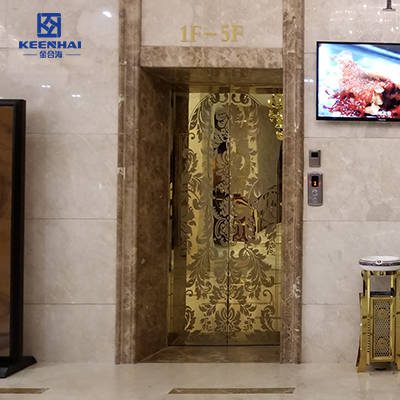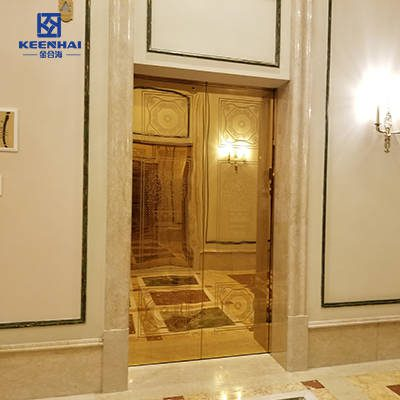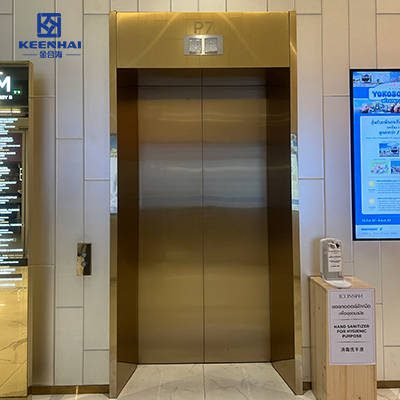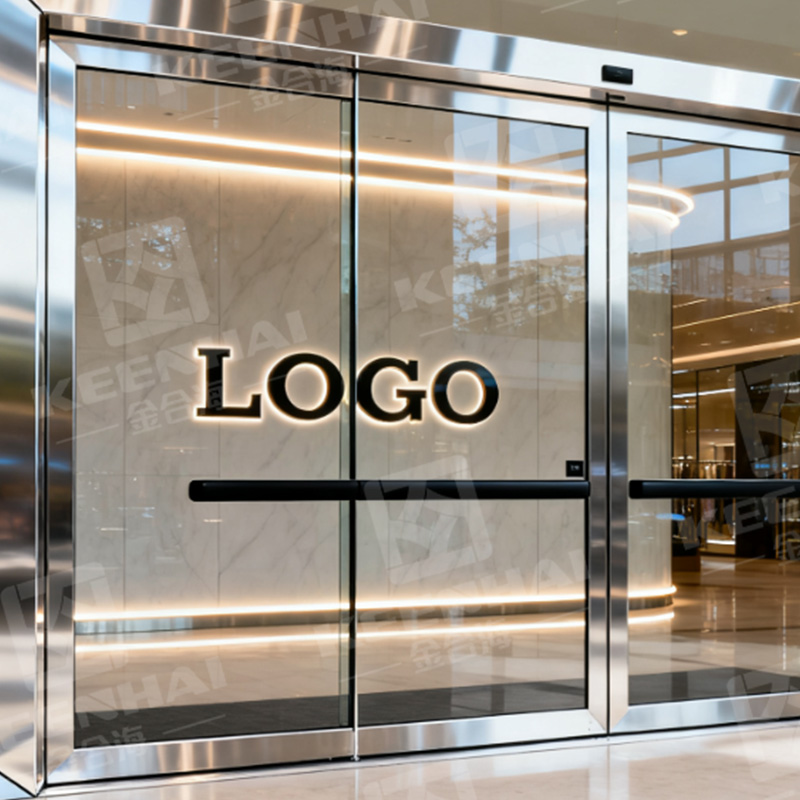Choosing the right stainless steel elevator door for hotels ensures durability and style. Our high-quality stainless steel doors are designed to handle heavy traffic, resist scratches, and maintain a sleek look. Whether you need brushed, mirror, or PVD finishes, we provide customized solutions that match your hotel’s interior while offering long-lasting performance.
1. Material Selection
1.1 Stainless Steel Grades Suitable for Hotels
Selecting the right stainless steel grade is essential for hotel elevators, where aesthetics, durability, and maintenance all matter. The two most common options are 304 û 316 polayê zengarnegir. Grade 304 is widely used for interior applications, offering excellent corrosion resistance and cost-effectiveness. Grade 316 adds molybdenum, boosting resistance to moisture, cleaning chemicals, and high-humidity environments—ideal for coastal hotels or spa areas.
For instance, in a boutique hotel in Miami, our premium stainless elevator panels made with 316 stainless steel were installed in the lobby and spa elevators. Despite daily exposure to steam and frequent cleaning, the doors maintained their smooth, polished look without showing rust or discoloration.
1.2 Corrosion Resistance and Durability
Hotels experience high traffic, which means elevator doors must endure thousands of daily cycles. Corrosion resistance is critical not just for longevity, but also to prevent staining and maintain a luxurious appearance. Brushed or hairline finishes help conceal minor scratches, while mirror or PVD-coated panels offer a more upscale look but require slightly more maintenance.
Here’s a quick comparison for hotel applications:
| Stainless Steel Grade | Berxwedana Korozyonê | Durability | Ideal Use |
|---|---|---|---|
| 304 | High, general indoor environments | Strong, resists scratches | Standard hotel elevators |
| 316 | Very high, humid or coastal environments | Very strong, resists heavy wear | Spa, pool, rooftop, or coastal hotels |
In a high-rise hotel in New York, our 304 stainless steel doors were chosen for guest elevators in the main lobby. They handled over 500 cycles per day, showing minimal wear and maintaining a consistent aesthetic for several years.
1.3 Surface Finish Options (Brushed, Mirror, Hairline, PVD Coatings)
The finish impacts both the visual appeal and maintenance of hotel elevator doors.
-
Brushed Finish – Subtle lines hide fingerprints and small scratches; perfect for commercial lobbies with moderate traffic.
-
Mirror Finish – High reflectivity offers a luxurious look but requires more cleaning; ideal for boutique or high-end hotels.
-
Hairline Finish – Linear, contemporary style that balances elegance and practicality; conceals minor wear.
-
PVD Coatings – Gold, bronze, or black finishes add a premium feel and resist corrosion, fading, and scratches; excellent for themed or signature hotel interiors.
In a Los Angeles hotel, our stainless steel elevator doors with hairline finish complemented walnut wall panels and marble floors. Guests praised the cohesive, high-end design, while the hotel maintenance team appreciated the low upkeep requirement.
Practical Steps for Material Selection in Hotels:
-
Identify elevator traffic levels—main lobby vs service or guest elevators.
-
Choose the appropriate stainless steel grade (304 for standard use, 316 for high humidity or coastal locations).
-
Select a surface finish that balances aesthetics with ease of maintenance.
-
Consider PVD coatings if a unique color or premium look is desired.

2. Design and Aesthetic Considerations
2.1 Panel Styles and Patterns for Hotel Lobbies
Choosing the right panel style can dramatically impact the first impression guests get in a hotel lobby. Elevator doors are often one of the first things noticed, so they should complement the overall interior design. Common styles include flat panels for a minimalist look, vertical grooves for modern elegance, and geometric patterns for a bold statement.
For example, in a boutique hotel in Chicago, our stainless steel elevator panels with subtle vertical grooves added a contemporary feel without overpowering the marble flooring and wooden accents. This approach allowed the elevators to blend seamlessly with the lobby while maintaining a sleek, professional look.
2.2 Color and Coating Choices for Luxury or Modern Interiors
Color and coating options can elevate the visual appeal and help match the hotel’s theme. Brushed stainless steel provides a timeless silver look, while PVD-coated panels can offer gold, bronze, or black finishes, ideal for luxury or boutique hotels. Mirror finishes reflect light, enhancing the sense of space and giving a premium feel.
Here’s a simple comparison of popular finishes for hotel elevators:
| Finish Type | Visual Effect | Maintenance Needs | Ideal Hotel Style |
|---|---|---|---|
| Brushed | Subtle, professional | Nizm | Most hotel lobbies |
| Mirror | Reflective, luxurious | Medya | High-end boutique hotels |
| Hairline | Contemporary, conceals scratches | Nizm | Modern or minimalistic hotels |
| PVD Coating | Custom color, premium feel | Medya | Signature or themed hotels |
At a high-rise hotel in Los Angeles, we installed PVD-coated black stainless steel panels in the VIP elevator. Guests were impressed by the sleek, high-end look, and the hotel management appreciated how the coating reduced visible fingerprints compared to a mirror finish.
2.3 Integration with Elevator Interior Design
Aesthetic considerations shouldn’t stop at the door. The panels should complement the elevator cabin, lighting, and wall materials. Materials like wood veneer, glass, or leather can be incorporated alongside stainless steel for a layered, luxurious feel. Lighting, especially LED strips along the ceiling or side panels, enhances the door’s texture and color.
Practical steps for integration:
-
Map the lobby and elevator cabin finishes before selecting panel style and coating.
-
Choose a panel texture and finish that matches or complements interior materials.
-
Consider lighting placement to highlight finishes without glare.
-
Test a sample panel in the lobby environment to ensure visual harmony.
In a boutique hotel in Miami, our stainless steel panels were paired with walnut veneer walls and warm LED lighting. The combination created a cohesive look, while the hairline finish minimized fingerprints in high-traffic areas, making the design both practical and visually appealing.

3. Dimensions and Installation
3.1 Standard vs Custom Sizes for Hotel Elevators
Hotel elevators vary widely in size, so choosing the right door dimensions is crucial for smooth operation and visual balance. Standard sizes work well for most mid-sized hotels, where elevator shafts follow common dimensions. Custom sizes become necessary for boutique or luxury properties with non-standard shafts, unique lobby layouts, or aesthetic requirements.
In a boutique hotel in San Francisco, we fabricated custom elevator panels to match an unusually wide shaft. This allowed for seamless integration with the lobby’s marble walls, giving the space a premium feel while ensuring doors opened smoothly every time.
3.2 Thickness, Weight, and Door Mechanism Compatibility
Door thickness and weight directly impact the elevator’s performance and longevity. Thicker panels provide added durability and better sound insulation but require stronger door mechanisms. Conversely, thinner panels reduce load on the system but may be more prone to dents.
Here’s a practical comparison for hotel applications:
| Panel Thickness | Typical Weight | Recommended Mechanism | Ideal Use |
|---|---|---|---|
| 1.2 mm | Light | Standard hydraulic or traction | Low to medium traffic hotels |
| 1.5 mm | Medya | Reinforced traction or high-capacity hydraulic | Standard hotel lobbies |
| 2.0 mm | Heavy | Heavy-duty traction | High-traffic or luxury hotels |
In a 5-star hotel in Chicago, our 1.5 mm brushed stainless steel elevator doors were installed. The hotel had high daily traffic, and the reinforced traction system ensured smooth operation without adding stress to the mechanism.
3.3 Aligning with Existing Elevator Shafts and Frames
Proper alignment is critical to prevent operational issues like sticking, uneven gaps, or premature wear. Steps for accurate installation include:
-
Measure Existing Shaft and Frame: Record width, height, and any irregularities.
-
Select Compatible Panel Dimensions: Ensure clearance for smooth sliding or folding mechanisms.
-
Check Weight Load: Confirm the door mechanism can handle the panel weight.
-
Test Fit Before Final Installation: Temporarily mount panels to check alignment and clearance.
-
Secure and Seal: Once confirmed, fix panels and apply finishing trim for a polished look.
At a luxury hotel in Los Angeles, our elevator door panels were custom-fabricated to match an older shaft with slightly tapered edges. Temporary mounting allowed adjustments, ensuring doors closed evenly and aligned perfectly with the cabin interior. Guests appreciated the smooth operation and seamless design integration.

4. Maintenance and Longevity
4.1 Cleaning and Upkeep Requirements
Maintaining hotel elevator doors in pristine condition requires regular cleaning and a practical approach tailored to the finish. Brushed stainless steel is forgiving, hiding fingerprints and minor scratches, and can be cleaned with a mild detergent or stainless steel cleaner. Mirror or PVD-coated finishes provide a premium look but show smudges more easily, requiring soft microfiber cloths and gentle cleaning solutions.
In a high-traffic hotel in New York, our brushed stainless steel elevator doors were cleaned twice daily by housekeeping staff. Despite thousands of daily uses, the doors maintained their luster with minimal effort, proving that choosing the right finish reduces long-term labor costs.
4.2 Resistance to Scratches, Wear, and High Traffic
Durability is critical in hotels where elevators face continuous use. Scratches, dents, and surface wear can quickly degrade the appearance if the wrong materials are chosen. The choice of stainless steel grade, panel thickness, and finish all influence longevity.
Here’s a practical comparison:
| Taybetî | 304 Stainless Steel | 316 Stainless Steel | PVD Coating |
|---|---|---|---|
| Scratch Resistance | Medya | Bilind | High (surface-dependent) |
| Berxwedana Korozyonê | Bilind | Very High | Very High |
| Ideal Traffic Level | Moderate | Bilind | High-end, moderate to high |
In a Miami beachfront hotel, 316 stainless steel panels were chosen for poolside elevators. Despite exposure to humidity, chlorine, and frequent guest use, the doors remained corrosion-free and scratch-resistant for years, maintaining both aesthetics and functionality.
4.3 Long-Term Performance and Cost Efficiency
Investing in high-quality materials upfront saves maintenance costs and prolongs service life. While PVD-coated or thicker panels may cost more initially, they reduce the need for frequent repairs or replacements. Durability also contributes to guest satisfaction, as doors that operate smoothly and look polished enhance the overall hotel experience.
Steps to maximize longevity:
-
Choose the appropriate stainless steel grade for the environment and traffic.
-
Select a finish that balances aesthetics with ease of maintenance.
-
Schedule routine inspections for alignment, lubrication, and minor repairs.
-
Train staff on proper cleaning methods and avoid abrasive tools.
In a boutique hotel in Los Angeles, combining 1.5 mm 316 stainless steel panels with a brushed finish allowed high-traffic elevators to stay pristine for over five years. Minimal maintenance and excellent wear resistance proved cost-effective compared to cheaper alternatives that would have required yearly replacements.
Ready to elevate your lobby? Explore hospitality-ready finishes in our hotel stainless steel elevator doors collection.






